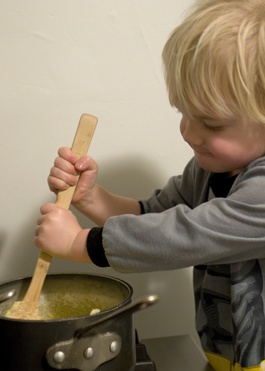
Italian housewives: the vital ingredient for a good polenta
Published on
Translation by:
 Amanda Mulligan
Amanda Mulligan
So all you need is salted water and cornmeal, right? Most certainly not! Modern instant recipes are no substitute for the real thing. It’s impossible to make good polenta without a bit of elbow grease and a lot of patience. Don’t forget the copper pot for cooking it in either
We all do whatever we can to protect ourselves from the harsh winter weather and undoubtedly one of the best measures is to confront it on a full stomach. Nobody can turn down a warm, wholesome dish and that is why, during the winter season in northern Italy, it is rare to find a dining table without polenta, a traditional ancient Italian dish made from water and cornmeal. Polenta is cooked for about an hour in a large pot usually made of copper and since the discovery of America it is almost always made with corn, to which we can attribute its distinctive yellow colouring. Spelt polenta, which was popular in ancient Rome, and Greek barley polenta have all but disappeared from the tables of northern Italy. However, buckwheat and wheat varieties can still be found.
While polenta is filling, it is not nutritious. Up until the post-war period, the ‘polentoni’ (those who ate polenta) of northern Italy suffered from serious food deficiencies (such as pellagra, a vitamin deficiency disease), because they subsisted almost entirely on this 'peasant dish' accompanied by whatever they were fortunate enough to find in their pantries - assuming of course that they had a pantry! Therefore serving polenta with other foods is not only a tasty option. It’s also absolutely necessary.
 To successfully make the basic recipe, sieved cornmeal added slowly to boiling salted water, you must not forget the vital ingredient: elbow grease. The secret to a great polenta is all in the stirring (the other trick is to always stir in the same direction, but keep that one under your hat!). So even today, despite the invention of electric polenta cookers, Italian housewives spend at least an hour continuously stirring until it reaches a thick, dense consistency and comes easily away from the side of the pot.
To successfully make the basic recipe, sieved cornmeal added slowly to boiling salted water, you must not forget the vital ingredient: elbow grease. The secret to a great polenta is all in the stirring (the other trick is to always stir in the same direction, but keep that one under your hat!). So even today, despite the invention of electric polenta cookers, Italian housewives spend at least an hour continuously stirring until it reaches a thick, dense consistency and comes easily away from the side of the pot.
It was once a custom but today making polenta is a wonderful opportunity for families to come together and chat while waiting for the piping hot dish, which is served on a warm, round wooden board. Every area has its own unique way of serving. For example, there are those who mix it up with lardo (cured pork fat) and cheese, those who flavour it with mushrooms and those who enrich it with butter and cream. In the past the hard leftover crust was dunked in milk the next day. Today, it is eaten as a snack. Polenta will warm you to the core and makes a wonderful accompaniment to many dishes, such as fowl, game, beef and cheese. It’s a staple holiday food eaten at christmas. On new year’s day, it is served with ‘lucky lentils’, which symbolise good fortune for the coming year.
It may be that a time-honoured tradition is being threatened by sachets of instant polenta that promise the same great taste in a fraction of the time, or by chefs offering us ‘polenta soup’ that cannot be cut into slices. But that first polenta of the year will always remain the definitive sign that winter has arrived. It’s a custom that will survive in spite of the vagaries of climate change.
First published on cafebabel.com on 14 January 2010
Images: ©paige_eliz; ©jspace3; ©pirate johnny; ©Kaptain Kobold all courtesy of flickr
Translated from A fà la polenta ghe voeur l'oli de gombed


